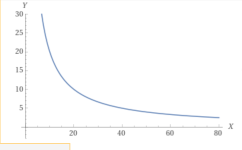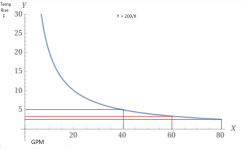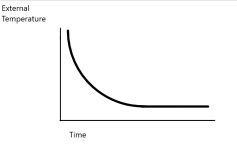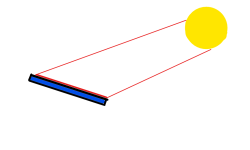- Nov 12, 2017
- 12,636
- Pool Size
- 12300
- Surface
- Plaster
- Chlorine
- Salt Water Generator
- SWG Type
- Pentair Intellichlor IC-40
I'm pretty sure you have this wrong. Running less flow in the morning is going to save on electricity, but the heat exchange will also drop. And it is not a direct ratio. You'll be getting less heat exchange not because there is less available heat, but because you are getting more heat loss (as others have explained above). Even though the panels may be heating the water in them some amount, without enough flow you won't be effectively increasing the pool's temperature. You won't be saving electricity, you'll just be wasting it.
Think of it this way. It's a common misconception, when DIYer's are trying to fool pool-heating physics, they'll loop a bunch of black drip tubing around and around and hook up a little pump to it, and run pool water through it. They'll feel really hot water coming out of the tube and declare themselves genius because they've cracked the solar heating industry wide open, for just a few dollars!! (And they'll swear their pools are getting really warm from doing so.) Hooey. Yes, the slower you run water through any sort of heat exchange tubing the hotter the water will get. But that hot water, at that reduced flow rate, won't heat your pool any noticeable amount. And even though these miracle machines are using very little electricity, pumping a little water with a little pump, that electricity is virtually 100% wasted. That setup is not doing anything, at all. You thinking that reducing the flow rate in the morning to sneak out a little "free heat" is just another variation of this DIYer fantasy.
Contrast that with a solar installer that doesn't have a proper flow meter to optimize flow through a "real" set of panels, he'll get the system going and stick his hand in the pool in front of a return. He'll increase the flow rate until the water coming out of the return is just barely warmer than the pool, because he understands the principal, the physics, that is actually at work. Moving a lot of water that is just slightly warmer than the pool will heat it faster than moving a little water that is much hotter than the pool. It's counterintuitive, but the physics are what they are.
If you're trying to save money because of your usage rates, you're going about it wrong. You think pushing water through your panels at the flow required for your SWG will get you a little "free heat." There is no such thing. All you'll be doing is pushing water up on your roof and wasting the electricity to do so, without significantly adding heat to your pool, even though you'll think it's working because the water out of your returns feels warm. And it will be. It just won't heat your pool worth a darn. You would be much better off starting the pump and the solar heating an hour or two later, but at the panels' optimal flow rate, and heating the pool more efficiently. The only way to save electricity without running the optimal flow rate through the panels is to not run your pump at all. Four hours of very inefficient heat exchange will not work out to be cheaper than one hour at optimal heat exchange, in terms of actually heating your pool.
Pardon the tough love: there are many threads here that describe how to cheat the physics, with tricks or gizmos to heat pools for practically nothing. They don't. You won't.
Think of it this way. It's a common misconception, when DIYer's are trying to fool pool-heating physics, they'll loop a bunch of black drip tubing around and around and hook up a little pump to it, and run pool water through it. They'll feel really hot water coming out of the tube and declare themselves genius because they've cracked the solar heating industry wide open, for just a few dollars!! (And they'll swear their pools are getting really warm from doing so.) Hooey. Yes, the slower you run water through any sort of heat exchange tubing the hotter the water will get. But that hot water, at that reduced flow rate, won't heat your pool any noticeable amount. And even though these miracle machines are using very little electricity, pumping a little water with a little pump, that electricity is virtually 100% wasted. That setup is not doing anything, at all. You thinking that reducing the flow rate in the morning to sneak out a little "free heat" is just another variation of this DIYer fantasy.
Contrast that with a solar installer that doesn't have a proper flow meter to optimize flow through a "real" set of panels, he'll get the system going and stick his hand in the pool in front of a return. He'll increase the flow rate until the water coming out of the return is just barely warmer than the pool, because he understands the principal, the physics, that is actually at work. Moving a lot of water that is just slightly warmer than the pool will heat it faster than moving a little water that is much hotter than the pool. It's counterintuitive, but the physics are what they are.
If you're trying to save money because of your usage rates, you're going about it wrong. You think pushing water through your panels at the flow required for your SWG will get you a little "free heat." There is no such thing. All you'll be doing is pushing water up on your roof and wasting the electricity to do so, without significantly adding heat to your pool, even though you'll think it's working because the water out of your returns feels warm. And it will be. It just won't heat your pool worth a darn. You would be much better off starting the pump and the solar heating an hour or two later, but at the panels' optimal flow rate, and heating the pool more efficiently. The only way to save electricity without running the optimal flow rate through the panels is to not run your pump at all. Four hours of very inefficient heat exchange will not work out to be cheaper than one hour at optimal heat exchange, in terms of actually heating your pool.
Pardon the tough love: there are many threads here that describe how to cheat the physics, with tricks or gizmos to heat pools for practically nothing. They don't. You won't.





